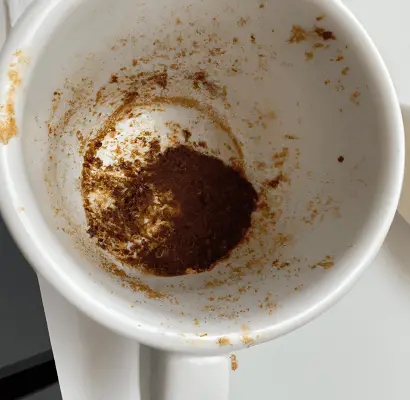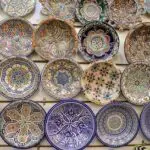Greek coffee is known for its foamy brim with a thick, velvety consistency and its importance to Greek culture. If you’ve tried to drink Greek coffee standing up or in a rush, you probably caught a mouthful of grainy grounds. While Greek coffee can have a fine, thick swirl of velvety coffee grounds, it shouldn’t taste gritty.

Greek coffee has a grainy texture because it is cooked together with the beans and not filtered like many other types of coffee. The coffee grounds remain in the cup if the coffee is left to rest for 5 minutes after brewing and then drunk slowly.
This article discusses Greek coffee’s unique texture, its unfiltered nature, and the best kind of beans, grind, and coffee grinder to use to make the perfect cup of coffee that would make a Greek barista proud.
Why is Greek Coffee Grainy?
If you’re not used to it, or if Greek coffee is poured or drunk too quickly, it can get gritty in your mouth.
That’s because Greek coffee is boiled with the grounds instead of brewed and filtered. This creates a thick, soft texture as the grounds sink to the bottom of the tall and narrow briki vessel as the water recedes. When served, most of the softened grounds should settle to the bottom of your demi-tasse cup.
There are three sections to Greek coffee. These include the signature foam (kaimaki) on top, the coffee drink in the center of the cup, and the grounds that settle at the bottom.
While Greek coffee is thick and black, it’s not meant to be consumed down to the last drop. Instead, drink it slowly, like a Greek, don’t rush the process, and avoid sipping right down to the grounds at the bottom.
Can You Filter Greek Coffee
Greek coffee is not filtered. The essence of Greek coffee is comprised of three parts: the foam bubbles floating on top, the coffee beverage in the middle of the cup, and the thick, velvety sludge of grounds at the bottom.
If you try to filter a cup of Greek coffee, you’ll remove the important part of Greek coffee. This is the coffee beans that are cooked with the liquid until they reach a fluffy cocoa powder texture.
Rather than trying to strain or filter Greek coffee, the key is to slow down and enjoy it as the Greeks do. The nature of Greek coffee forces fast-paced travelers to sit, relax, and sip to avoid choking on any grainy grounds lingering at the bottom of the cup.
If you don’t enjoy Greek coffee, you can always ask for an “ena café filtrou,” or instant, filtered coffee when in the country.
How to Grind Coffee Beans for Greek Coffee
Getting the grind right is essential for making a cup of Greek coffee that isn’t overly grainy or gritty.
Keep in mind that the coarser the grind, the less likely the grounds are to soften in the boiling water. This can leave a grainy sludge at the bottom of your cup instead a silky swirl.
When you’re grinding fresh coffee, you will want to aim for an extra-fine grind from dark roasted beans. It’s also possible to use a medium grind with some fruity notes. A Greek coffee grind is extremely fine and much finer than an espresso grind. You’ll know you have the right texture if your ground coffee beans look and feel like powder or flour.
Just make sure to pour carefully, let the grounds settle to avoid getting a mouthful of coffee granules, and you’re all set to enjoy a slow, thick cup of Greek delight.
What Kinds of Coffee Beans Should You Use for Greek Coffee?
It’s a myth that grinding your favorite (or available) coffee bean into fine dust will result in Greek-style coffee.
When in Greece, the law ensures that all coffee shops in the country have to serve Greek coffee to customers. If you’re drinking “Greek coffee” at Starbucks in Greece, keep in mind that a caffeinated drink labeled “Greek coffee” may not look or taste like one.
Genuine Greek coffee is crafted from certain Arabica blends, with precise roasting temperatures, and using specific bean ratios. You can find the right kind of coffee bean blends to use for Greek coffee by looking for a Greek, Arab, or Turkish place that roasts and grinds Greek-style coffee.
You can also check any local ethnic markets. Another easy way to ensure that you get an authentic taste and texture is to order a Greek coffee brand such as Loumidis or Bravo online.
Which Greek Coffee Grinder Should You Use?
Set yourself up for success when making Greek coffee by using the right grinder. This means either going old school with a traditional mortar and pestle or investing in a good burr grinder.
For thousands of years, the Greeks have used mortar and pestle as culinary tools. A mortar is a stone or ceramic vessel shaped like a bowl. It has a smaller, matching stone pestle that crushes ingredients to grind them into powder.
Since these tools are often used to make culinary staples in Greek culture, it is a perfect way to reduce coarser ground coffee beans into fine, powdery dust that’s essential to create Greek coffee.
If you prefer to use a less basic method or grind more coffee at once, consider getting a burr grinder as another way to grind your own coffee at home.
Don’t have either a mortar and pestle or a burr grinder, you can also put coffee beans in a food processor on the finest setting and grind them for several minutes until they reach a texture like a confectioner’s sugar.
Once you’ve ground the beans to the right consistency, you’re ready for the next step to start making Greek coffee.
Final Thoughts
Get the perfect cup of Greek coffee and avoid an extra grainy or gritty texture by giving the coffee time to settle,
It’s also important if you’re making Greek coffee at home to make sure that you grind the proper beans on an extra fine setting using a burr grinder. This will ensure a powdery grind that helps give your Greek coffee a smoother and silkier texture.
- The Top Restaurants Specializing in Truffle Dishes - August 10, 2023
- Truffle Panna Cotta: A Decadent Dessert Recipe for Truffle Lovers - August 7, 2023
- Truffle Scrambled Eggs: A Luxurious Breakfast Delight - August 7, 2023








